- 0086-571-85302990
- sales@greenskybio.com
Natural Grape Seed Extract: From Leaves to Extraction.
2024-11-11

The Importance of Grape Leaves
Grape leaves play a crucial role in the growth and development of grapes. They are not just an accessory part of the grapevine but are integral to the overall health and quality of the grapes. Photosynthesis is one of the primary functions of grape leaves. Through this process, leaves convert sunlight, carbon dioxide, and water into glucose and oxygen. This glucose serves as the main source of energy for the grapevine, which is then used for various physiological processes such as growth, fruit development, and the synthesis of other important compounds.
The health of the grape leaves also affects the nutrient uptake of the grapevine. A healthy leaf can efficiently absorb nutrients from the soil, such as nitrogen, phosphorus, and potassium, and transport them to other parts of the plant, including the grapes. Nutrient - rich grapes are more likely to produce high - quality seeds, which are the source of Grape Seed Extract. For example, if the leaves are suffering from nutrient deficiencies, it can lead to stunted growth of the grapes and poor seed development.
Moreover, grape leaves act as a natural defense mechanism for the grapes. They contain certain compounds that can protect the grapes from pests and diseases. For instance, some phenolic compounds in the leaves have antimicrobial and antioxidant properties. These compounds can be transferred to the grapes, either directly or through the plant's internal transport system, enhancing the overall resistance of the grapes and potentially influencing the properties of the grape seeds.
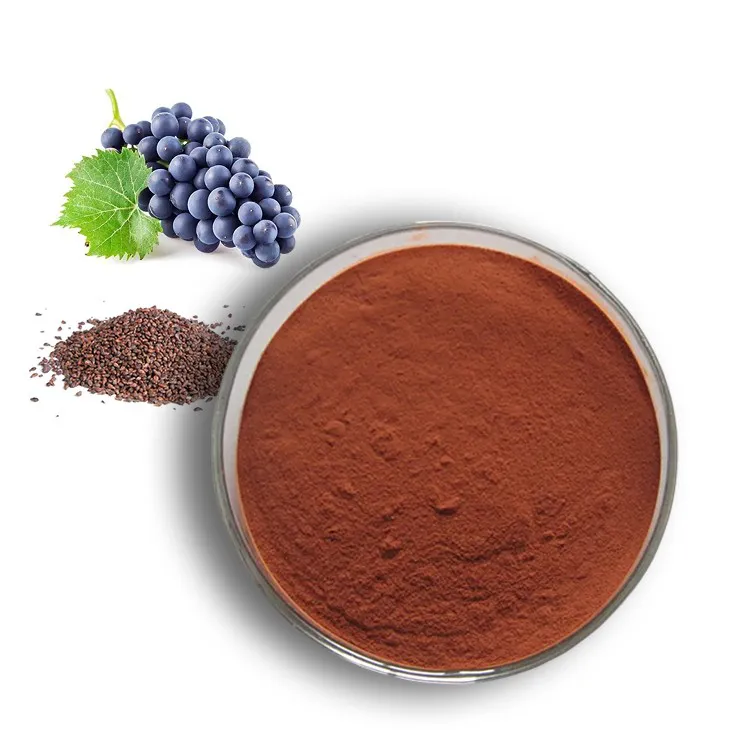
Grape Varieties and Their Influence on Grape Seeds
There are numerous grape varieties around the world, each with its own unique characteristics. These characteristics play a significant role in determining the quality of the grape seeds and, consequently, the Grape Seed Extract.
Red Grape Varieties: Red grapes, such as Cabernet Sauvignon and Pinot Noir, are known for their rich phenolic content. Phenolic compounds, including flavonoids and phenolic acids, are concentrated in the seeds of these grapes. These compounds contribute to the antioxidant properties of the Grape Seed Extract. For example, flavonoids like proanthocyanidins are powerful antioxidants that can scavenge free radicals in the body, protecting cells from oxidative damage.
White Grape Varieties: While white grapes, like Chardonnay and Sauvignon Blanc, generally have a lower phenolic content compared to red grapes, they still contain valuable nutrients in their seeds. The seeds of white grapes may have different fatty acid profiles and other bioactive compounds. These differences can affect the extraction process and the potential applications of the grape seed extract. For instance, the fatty acids in white grape seed extract may have different emulsifying properties compared to those from red grape seed extract.
Seed Size and Structure: Different grape varieties also vary in terms of seed size and structure. Larger seeds may contain more extractable compounds, but they may also have a different composition compared to smaller seeds. The structure of the seed, such as the thickness of the seed coat and the distribution of cells within the seed, can influence the extraction efficiency. For example, a thicker seed coat may require more intensive extraction methods to release the internal compounds.
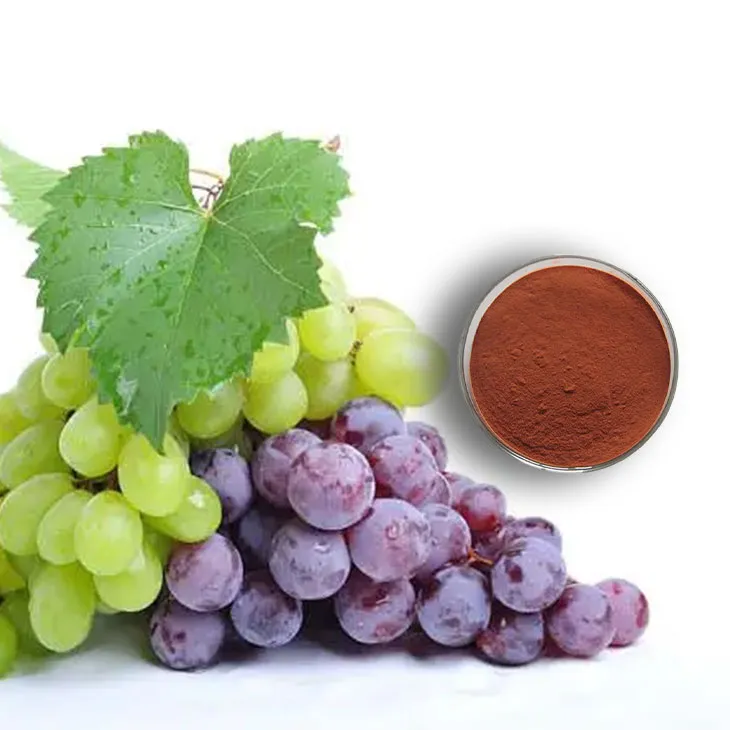
The Selection of Grapes for Grape Seed Extract
The selection of grapes for grape seed extract is a crucial step in ensuring the quality of the final product. It involves considering several factors related to the grapes and their leaves.
Maturity of Grapes: Grapes should be harvested at the appropriate stage of maturity. If grapes are harvested too early, the seeds may not have fully developed, resulting in a lower content of bioactive compounds. On the other hand, if grapes are overripe, there may be a degradation of some of the valuable compounds. For example, overripe grapes may have a higher level of sugars, which can lead to the Maillard reaction during extraction, potentially affecting the quality of the extract.
Health of the Grapevine and Leaves: As mentioned earlier, the health of the grapevine and its leaves is directly related to the quality of the grapes and their seeds. Grape bunches from healthy vines with vibrant leaves are more likely to produce high - quality seeds. Diseased or stressed vines may produce grapes with lower nutrient content and poorer - quality seeds. Therefore, careful inspection of the grapevine and its leaves is necessary before grape selection.
Source and Cultivation Conditions: The source of the grapes, whether they are from a specific vineyard or region, can also impact the quality of the grape seed extract. Grapes grown in different regions may be exposed to different environmental conditions, such as soil type, climate, and altitude. These factors can influence the chemical composition of the grapes and their seeds. For example, grapes grown in cooler climates may have a different phenolic profile compared to those grown in warmer regions.
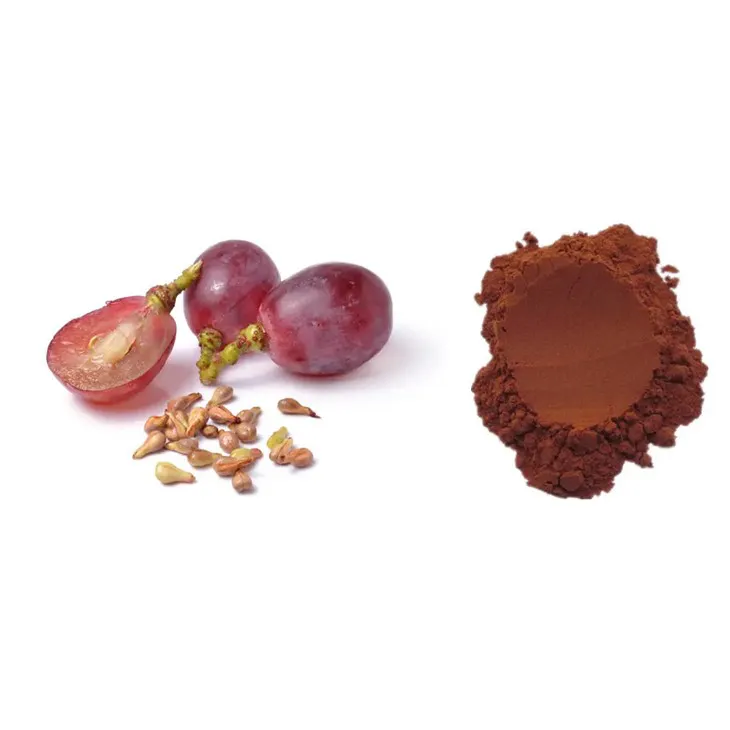
The Extraction Process of Grape Seed Extract
The extraction of grape seed extract is a complex and precise process that can be divided into several steps.
Step 1: Pretreatment of Grape Seeds
Before extraction, grape seeds need to be pretreated. This involves cleaning the seeds to remove any impurities such as dirt, stalks, or pieces of grape pulp. Cleaning can be done using methods like washing with water or air - blowing to remove loose debris. After cleaning, the seeds may be dried to a certain moisture content. Drying is important as it can affect the subsequent extraction steps. If the seeds are too wet, it can lead to problems such as mold growth during extraction, while if they are too dry, it may make the extraction more difficult.
Step 2: Grinding or Crushing
The next step is to grind or crush the grape seeds. This process breaks down the seed structure, increasing the surface area available for extraction. Grinding can be done using mechanical grinders or crushers. The degree of grinding or crushing should be carefully controlled. If the seeds are ground too finely, it may lead to problems such as clogging during extraction, while if they are not ground enough, the extraction efficiency will be low. For example, a fine powder may require a different extraction solvent or method compared to coarser particles.
Step 3: Extraction with Solvents
Once the seeds are ground or crushed, extraction with solvents is carried out. Common solvents used for grape seed extraction include ethanol, methanol, and water. Ethanol is often preferred as it is a relatively safe and effective solvent. The choice of solvent depends on various factors such as the solubility of the target compounds in the solvent, the cost of the solvent, and the safety considerations. During extraction, the ground seeds are mixed with the solvent in a suitable container, and the mixture is stirred or shaken to ensure good contact between the seeds and the solvent. The extraction time and temperature also need to be carefully controlled. Higher temperatures may increase the extraction rate, but it can also lead to the degradation of some heat - sensitive compounds.
Step 4: Filtration and Separation
After extraction, the mixture needs to be filtered to separate the extract from the solid residues. Filtration can be done using various methods such as filter paper, membrane filtration, or centrifugation. Filter paper is a simple and commonly used method for small - scale extractions. Membrane filtration can be more precise and is suitable for removing smaller particles. Centrifugation is a more efficient method for separating the liquid extract from the solid particles. After filtration, the extract may be further purified or concentrated depending on the requirements.
Step 5: Concentration and Drying
The final steps in the extraction process are concentration and drying. Concentration is used to increase the concentration of the active compounds in the extract. This can be done by methods such as evaporation under reduced pressure or by using a rotary evaporator. Drying is then carried out to obtain a dry powder form of the grape seed extract. Drying methods include spray drying, freeze - drying, and oven drying. Spray drying is a fast and efficient method for large - scale production, while freeze - drying can better preserve the bioactive compounds in the extract.
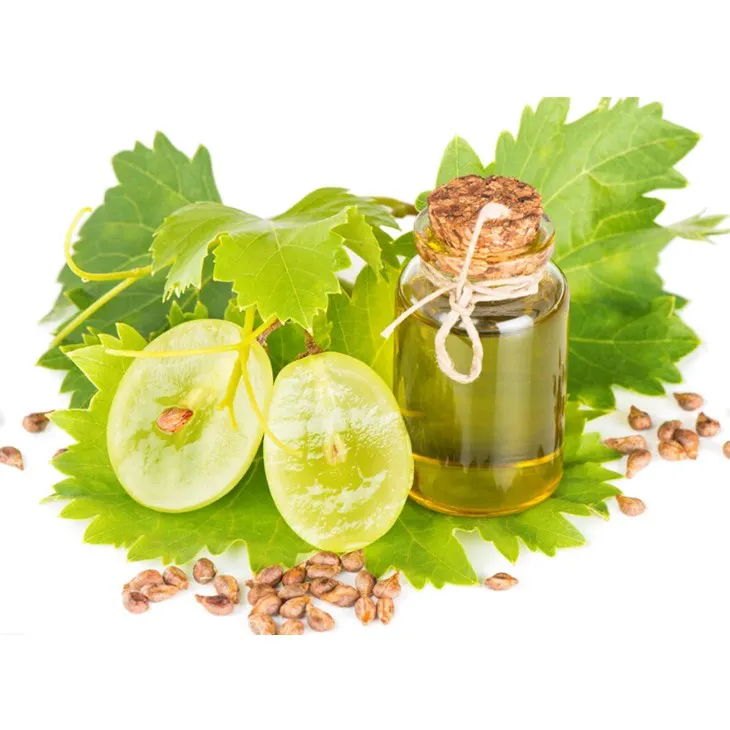
Quality Control of Grape Seed Extract
Quality control is essential in the production of grape seed extract to ensure its safety, efficacy, and consistency.
Analysis of Chemical Composition: One of the key aspects of quality control is the analysis of the chemical composition of the extract. This includes determining the content of phenolic compounds, flavonoids, fatty acids, and other bioactive components. High - performance liquid chromatography (HPLC) and gas chromatography - mass spectrometry (GC - MS) are some of the analytical techniques used for this purpose. By analyzing the chemical composition, producers can ensure that the extract meets the required standards in terms of its active ingredients.
Purity and Contaminant Testing: Purity testing is also important to ensure that the grape seed extract is free from contaminants such as pesticides, heavy metals, and microbial contaminants. Pesticide residues can be analyzed using methods like liquid chromatography - tandem mass spectrometry (LC - MS/MS). Heavy metal content can be determined using atomic absorption spectrometry (AAS) or inductively coupled plasma - mass spectrometry (ICP - MS). Microbial testing includes checking for the presence of bacteria, fungi, and yeasts. This is typically done by culturing samples on appropriate media and counting the colonies.
Stability Testing: Grape seed extract should be stable over time to ensure its effectiveness. Stability testing involves subjecting the extract to different environmental conditions such as temperature, humidity, and light and monitoring its chemical and physical properties over a period of time. This helps to determine the shelf - life of the extract and any storage requirements. For example, if the extract is found to be sensitive to light, it may need to be stored in a dark container.
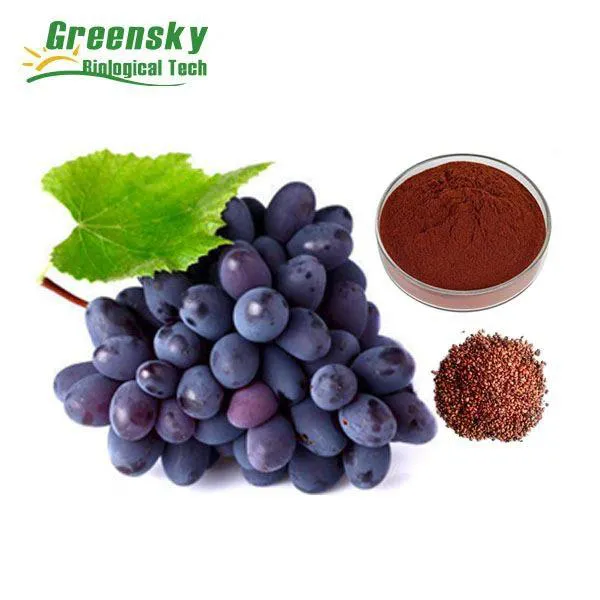
Applications of Grape Seed Extract
Grape seed extract has a wide range of applications in various fields due to its rich composition of bioactive compounds.
Cosmetic Industry: In the cosmetic industry, grape seed extract is used for its antioxidant and anti - aging properties. It can be added to skincare products such as creams, lotions, and serums. The antioxidants in the extract help to protect the skin from free radical damage, which can cause premature aging, wrinkles, and dullness. For example, grape seed extract can be used in anti - wrinkle creams to improve skin elasticity and reduce the appearance of fine lines.
Food and Beverage Industry: Grape seed extract is also used in the food and beverage industry. It can be added as a natural antioxidant to preserve the freshness and quality of food products. In beverages, such as fruit juices and wines, it can enhance the antioxidant content and potentially improve the taste. For example, some winemakers add a small amount of grape seed extract to red wines to increase their antioxidant properties and improve their stability during storage.
Pharmaceutical and Nutraceutical Industry: In the pharmaceutical and nutraceutical industries, grape seed extract is being studied for its potential health benefits. It has been shown to have anti - inflammatory, anti - cancer, and cardiovascular protective properties. For example, some studies suggest that the flavonoids in grape seed extract may help to reduce inflammation in the body, which is associated with various chronic diseases. In nutraceutical products, it can be formulated as dietary supplements to provide consumers with the benefits of its bioactive compounds.
Conclusion
Natural grape seed extract is a remarkable substance with a complex origin starting from grape leaves. The journey from the selection of grapes, considering the influence of grape leaves and grape varieties, to the meticulous extraction process, and finally to its various applications is a fascinating one. Through careful attention to every step, from grape cultivation to extraction and quality control, high - quality grape seed extract can be produced. As research continues to uncover more about its properties and potential applications, the importance of this natural extract is likely to grow in the future.
FAQ:
1. What is the role of grape leaves in the production of Natural grape seed extract?
Grape leaves contribute to the overall health and nutrient content of the grapes. This, in turn, affects the quality of the grape seeds, which are the source of the grape seed extract.
2. How is the suitable grape variety selected for grape seed extract?
The selection of suitable grape varieties for grape seed extract takes into account various factors. One important factor is the condition of their leaves. Grape varieties with healthy and well - nourished leaves are more likely to produce high - quality seeds for extraction.
3. What are the scientific extraction procedures for grape seed extract?
The scientific extraction procedures for grape seed extract typically involve several steps. First, the grapes are carefully harvested. Then, the seeds are separated from the rest of the grape components. After that, various extraction methods such as solvent extraction or supercritical fluid extraction may be used. These methods are designed to isolate the beneficial compounds in the grape seeds while maintaining their integrity and potency.
4. Why is precision important in the extraction of grape seed extract?
Precision is important in the extraction of grape seed extract because any deviation in the process can affect the quality and effectiveness of the final product. Small changes in factors such as temperature, pressure, or extraction time can lead to differences in the composition of the extract. This can impact its nutritional value, antioxidant properties, and potential health benefits.
5. How does the quality of grape leaves impact the final grape seed extract?
The quality of grape leaves has a direct impact on the final grape seed extract. Healthy grape leaves contribute to the growth and development of grapes, which in turn affects the quality of the seeds. If the leaves are diseased or nutrient - deficient, it can lead to lower - quality seeds and ultimately a less effective grape seed extract.
Related literature
- The Role of Grape Leaves in Grape Quality and Grape Seed Extract Production"
- "Grape Variety Selection for Optimal Grape Seed Extract: A Comprehensive Review"
- "Scientific Extraction Techniques for High - Quality Grape Seed Extract"
- ▶ Hesperidin
- ▶ citrus bioflavonoids
- ▶ plant extract
- ▶ lycopene
- ▶ Diosmin
- ▶ Grape seed extract
- ▶ Sea buckthorn Juice Powder
- ▶ Beetroot powder
- ▶ Hops Extract
- ▶ Artichoke Extract
- ▶ Reishi mushroom extract
- ▶ Astaxanthin
- ▶ Green Tea Extract
- ▶ Curcumin Extract
- ▶ Horse Chestnut Extract
- ▶ Other Problems
- ▶ Boswellia Serrata Extract
- ▶ Resveratrol Extract
- ▶ Marigold Extract
- ▶ Grape Leaf Extract
- ▶ blog3
- ▶ blog4
- ▶ blog5
-
Organic Tongkat Ali extract powder factory.
2024-11-11
-
How to make powder with ashwagandha extract.
2024-11-11
-
Rosehip extract manufacturers from China.
2024-11-11
-
The best cat's claw extract in nature.
2024-11-11
-
Chinese Dandelion Leaf Extract Suppliers.
2024-11-11
-
Diosmin
2024-11-11
-
Red Vine Extract
2024-11-11
-
Pomegranate Extract
2024-11-11
-
Scutellaria Extract
2024-11-11
-
Andrographis Paniculata Extract Powder
2024-11-11
-
Baicalin
2024-11-11
-
Cranberry Extract
2024-11-11
-
Beetroot Powder
2024-11-11
-
Coconut Water Powder
2024-11-11
-
Yellow Pine Extract
2024-11-11





















